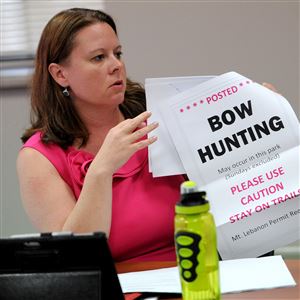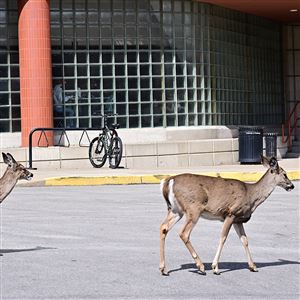Tonight’s public meeting of Mt. Lebanon commissioners was billed as a presentation of the final plans for a controlled archery hunt that could start as soon as Sept. 19.
But an unannounced guest plans to propose a new idea.
Kristen Tullo, newly installed Pennsylvania director of the Humane Society of the United States, is looking for a place to test an untried, experimental five-year deer sterilization program. Approval of such a program would require cancellation of the proposed archery hunt.
“We know that in closed populations, sterilization works,” Ms. Tullo said. “What we want to study — what we want to learn — is what happens in an open system with the movement of animals. Can [that procedure] still reduce the population?”
The program being proposed could cost as much as $200,000, half of which, she said, could be covered through a partnership with the Dietrich W. Botstiber Foundation, a Pennsylvania-based nonprofit known for funding programs to prevent cruelty to human beings and animals.
Ms. Tullo was invited to propose the plan by Ward 5 Commissioner Kelly Fraasch, a longtime advocate of nonlethal deer control who says she isn’t convinced all options have been explored.
“The commission agreed that sterilization is something we want to consider,” she said. “We need to explore this possibility presented by the Humane Society before taking other steps.”
Those steps include reconsidering a U.S. Department of Agriculture sharpshooter program that Mt. Lebanon discontinued in 2008. A USDA representative is expected to speak tonight. But the main attraction is tonight’s unveiling of final plans for the controlled archery hunt being organized by nonprofit wildlife management group White Buffalo.
Project manager Jody Maddock said the hunters and hunt managers have been vetted, properties enrolled and tree stands have been hung.
If approved, the experimental Humane Society plan would require a delay — perhaps up to five years — in the use of other control options.
Stephanie Boyles Griffin, senior director of the Humane Society’s Innovative Wildlife Management and Services division, said the proposal would include “surgical sterilization, immunocontraception or a combination of the two methods.” The goal, she said, would be to reach at least two-thirds of the doe population.
Surgical sterilization involves anesthetizing a doe and performing a tubal ligation or other procedure that renders it sterile. Immunocontraception involves a projectile that leaves the animal unable to conceive for two to three years, when it would need a booster shot. The proposed experiment would explore how well the procedures work in “open” areas into which wild, unfenced deer naturally move in and out.
“We get called in to do assessments all over the country,” Ms. Tullo said. “In this case we found Mt. Lebanon to be one of the places suitable to conduct this project. [White Buffalo President Tony] DeNicola came to the same conclusion.”
Mr. DeNicola said he spoke with Ms. Tullo and Ms. Griffin about helping them with a surgical sterilization program that has shown promise in previous experiments.
“Sterilization could work if you could get around the high-cost issue,” he said. “Contraceptives by dart can’t work. It has never worked on [unfenced] deer. I didn’t agree to participate in that kind of program.”
The Botstiber Foundation couldn’t be reached for comment.
Key to the Humane Society proposal is the support of the state Game Commission, which has never authorized a deer sterilization program. Ms. Tullo said she’s seeking Mt. Lebanon’s consent to conduct the experiment before approaching the Game Commission for a permit.
Mt. Lebanon’s goal is to reduce the deer-vehicle collision rate by 50 percent in five years. Experts from the Game Commission and other groups have said it’s unlikely that target could be reached through preventing deer from reproducing without also removing deer from the current population.
“We don’t know that,” Ms. Fraasch said. “We don’t know if the plan could work because it hasn’t been tried on open populations.
“That’s what we want to find out. … We still don’t know even how many deer there are. We don’t know how people in Mt. Lebanon feel about this issue because we’ve never conducted a poll.”
Duane Diefenbach, a deer biologist and adjunct associate professor of wildlife ecology at Penn State, suggested the sterilization of deer in open populations invites an inherent contradiction.
“[By] stopping reproduction but not doing anything to reduce the immediate deer population, the number of deer-vehicle collisions probably would continue,” he said. “Sterilized deer can live longer — eight or 10 years is not out of the realm of possibility. So, you’d have to have almost all of the deer treated in order for it to be effective.
“Two-thirds of does treated will slow reproduction but will not stop it. One-third of does will still reproduce, their offspring and their offspring will reproduce before the does that had been sterilized will die out. It will reach a new equilibrium.”
Mr. Diefenbach confirmed that contraception by dart has never been proved to work in an open deer population.
Tonight’s meeting has generated buzz in Mt. Lebanon.
“I’m sympathetic to the people who love deer. I love deer,” said Larry Schweiger, the newly installed president of PennFuture, an environmental and public health advocacy group, and former head of the National Wildlife Federation and Western Pennsylvania Conservancy.
Mr. Schweiger said communities across the eastern United States are struggling with deer over-browsing and learning that wildlife management sometimes requires conservation kills to maintain stable animal populations.
“There is a moral dimension to wildlife stewardship. But it may require a deeper understanding of science — a combination of what our heart says and what our head says,” Mr. Schweiger said. “Good stewardship is morally driven and scientifically based.”
The commission will hold a discussion session at 6:30 p.m., followed by a voting meeting at 8 p.m., in the municipal building.
John Hayes: jhayes@post-gazette.com or 412-263-1991.
First Published: September 8, 2015, 4:00 a.m.



















